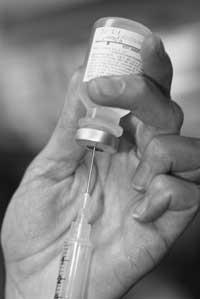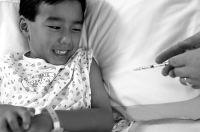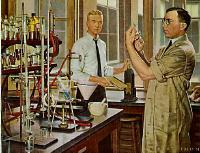Transplantation and gene therapy against diabetes
2000/06/24 Carton Virto, Eider - Elhuyar Zientzia
3.13% of the population of the Autonomous Community of the Basque Country live daily under insulin. They are diabetic and your body is not able to metabolize glucose. Therefore, if they don't want to have serious problems, they should take insulin with a vaccine. Getting insulin one, two or three times a day is essential if you don't want blood glucose levels to rise too much. Not everyone equally metabolizes artificial glucose and exercise, the type of work done or what is eaten, all of which influences the calculation of daily insulin doses. Servitude, therefore, is enormous.
Two types of diabetes
Two types of diabetes are known: Type 1 and type 2.
Type 1 diabetes is called juvenile diabetes because it appears in general youth. The area of patients with this type of diabetes does not work properly and are not able to produce insulin. Type 1 diabetes cannot be avoided beforehand, as it occurs when the immune system itself attacks the area. It is not known why it happens, but the patient should take artificial insulin every day. At the same time, it is essential to follow a strict diet and practice sport.
The type of diabate 2 appears in older people and is the most common type. The area of these people is able to flow insulin, but the body does not use it properly and blood glucose levels increase. As a result, the cells in the area grow and produce more insulin continuously and end up paralyzing. In some cases the proper diet regulates blood glucose levels, so these patients do not always depend on insulin. Diabetes is closely linked to the current lifestyle type 2: the important agents of the disease are sedentary lifestyle, obesity and lipid-rich diets, but family history also has a lot to say.
According to the World Health Organization, in 1990 there were 30 million diabetics worldwide. 10 years later the figure has multiplied by five and it has been announced that by 2010 there will be 250 million diabetics. But in addition to being an evil that is spreading, it is an evil that is investigated and it seems that in recent times have obtained encouraging results.
A group of Canadian researchers, for example, have worked on the transplant and succeeded. The technique has been used to treat type 1 diabetes, that is, the type of diabetes that appears when the area is damaged. Seven patients aged nine to fifty-four have been transplanted to the Langerhans islands (insulin-secreting cells), even healthier. The cells have reproduced within the patient, started secreting insulin and after a follow-up of almost a year, in general, they have not needed external insulin. Seven immediately outperformed the need to take insulin every day, even though those who received the least number of islands needed regular insulin doses.
Overcoming rejection

This type of transplant has been awarded previously but with very limited results. Thus, of the 267 transplants performed since 1990, 12.4% exceeded one week of operation and 8.2% one year. As in other transplants, in this case the most serious problem is rejection.
The islands of Langerhans are easily obtained from dead donors and transplantation is not complicated, but so far it has not been able to cope with rejection. However, it seems that Canadian researchers have found the right medicine and, at the moment, no patient has had rejection problems. Therefore, it seems that the transplant pathway to fight type 1 diabetes continues, although more tests and tests are still needed.
The president of the Gipuzkoa Diabetes Association, Juan Carlos Verdote, at least, is glad of the news. "It seems that what has not been achieved so far, overcoming rejection, has been achieved. The results follow the same line and the technique is fully developed."
He says these words with a point of skepticism rather than smiling, as many investigations that seem very good then fail. "However, if the seven patients who have received the transplant have had a good response and the cells are from dead people, that is, they are not synthetic, the word success can be cited," said Juan Carlos.
He also pointed out that they are looking forward to developing the technique and reaching the Hospitals of the Basque Country, although we will still have to wait a few years. "We were waiting for the insulin that was supposed to be taken by air and we received even more satisfactory news. If transplants progress, our quality of life will improve considerably, as we will not have to measure blood glucose levels every few hours or take injections. We should take anti-rejection pills and keep on maintaining the diet, but we would overcome insulin dependence."
Route of genes
Transplantation is not the only way to fight diabetes, and although it is still too early to say anything, gene therapy can give us good news.
One of the research is being conducted in Israel and in this case type 1 diabetes is also being studied. According to the researchers' hypothesis, liver cells could be transformed into insulin production by introducing appropriate genetic information.
As it is known for the protein to which insulin is subjected, the gene that encodes it was introduced into the liver cells of diabetic laboratory mice, with excellent results in 48 hours. During this time the mice started producing insulin and the blood glucose levels were reduced to normal, since 60% of the liver cells of the mice began to work if they were area cells. Tests have been done only with laboratory mice, but gene therapy has been shown to be a good treatment for diabetes.
Two forms of hope for diabetics: transplantation and gene therapy. Prevention is another way for non-diabetics. Type 1 diabetes cannot be avoided but type 2 diabetes can be avoided. A healthy diet and physical exercise are the most appropriate medications to combat the possible epidemic of the following century.
Growing conditionDiabetes is growing worldwide and especially in industrialized countries. The Basque Country, of course, is no exception, even here diabetics are increasingly numerous. According to data obtained from Osakidetza, 3.13% of the population of the Autonomous Community of the Basque Country is diabetic. 0,2-0,3% Type 1 diabetes and 2,93% Type 2 diabetes. 14% of the latter are treated by insulin injections, 56% by pills and 30% by diets. In addition, type 1 diabetes is ten times lower than type 2 diabetes. Between 10 and 12 of every 100,000 children under the age of 30 have this type of diabetes and 9 children under the age of 15. However, to this figure we must add those who do not know how to be diabetic, 4 per 100 inhabitants. As for Navarra and Iparralde, unfortunately we have not been able to find such data. |
Published in Zabalik

Gai honi buruzko eduki gehiago
Elhuyarrek garatutako teknologia





